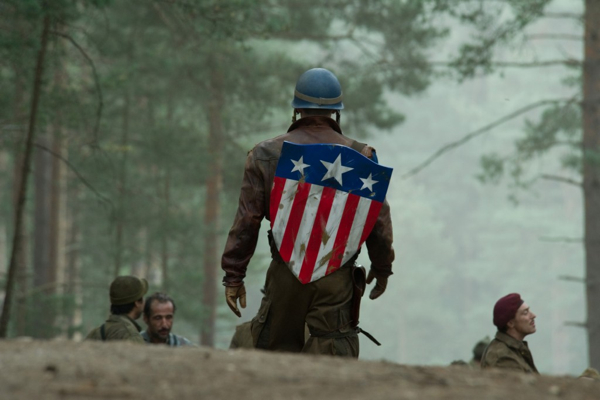Movie review by Greg Carlson
In the 2011 superhero movie derby, “Captain America: The First Avenger” emerges near the head of an underachieving class, capitalizing on its World War II timeframe and the accompanying sense of nostalgia inspired by the black and white simplicity of Allies vs. Axis. Punching the lights out of “The Green Hornet,” “Green Lantern,” and fellow masthead-mate “Thor,” “Captain America” comes in second only to the more sharply conceived and self-aware “X-Men: First Class,” another Marvel property enlivened by period pizzazz.
Director Joe Johnston recaptures the retro vibe of serialized style apparent in his 1991 feature “The Rocketeer,” although no amount of scrubbing will fully erase the stain of last year’s “The Wolfman,” a career nadir. Johnston’s workmanlike staging complements the leisurely origin story, an element as de rigueur to any comic book movie as the retooled costumes of the pulp icons. Skinny Steve Rogers (Chris Evans), the epitome of self-sacrificing, Greatest Generation patriotism, buffs up and bulges out with the aid of Dr. Abraham Erskine’s (Stanley Tucci) “Super Soldier Serum,” but before the weaponized New Yorker makes it behind enemy lines, the script sets up a delightful diversion showcasing both the original red, white, and blue tights and Cap’s theatrical flair for slugging Adolf Hitler in the mouth.
Johnston is slightly less successful once Captain America disobeys superiors like crusty Col. Chester Phillips (Tommy Lee Jones) and fashions a one-man rescue mission into soon-to-be nemesis Red Skull’s (Hugo Weaving) HYDRA facilities. Rogers is encouraged by Erskine to think for himself, and the advice leads to the soldier’s insubordination within the ranks of the U.S. military machine and also snuffs many potentially interesting characters and relationships as the Sergeant York-like hero goes-it-alone. The Captain’s hand-picked crew, including pals like Dum Dum Dugan and Bucky Barnes, scarcely functions as a coherent unit, and the story misses its opportunity to craft Dirty Dozen or Magnificent Seven bonhomie.
Even more disappointing is the immobilization of Steve’s crush Peggy Carter (Hayley Atwell), the stiff upper lip Brit officer from the Strategic Scientific Reserve. The only woman in the movie with more than a few seconds of screen time, Atwell suffers the “best girl’s” standard fate: removal from the central action sequences and a personality largely based on providing emotional support to the male hero. I suppose one could be grateful Carter gets to squeeze off some machine gun rounds and avoid the need to be rescued by Captain America, but why banish one of the very best things the movie has going for itself? Carter’s false modernity is represented by a handful of coded actions (i.e. a wicked hook to a sexist grunt) that fail to establish her as a genuine equal to her colleagues.
“Captain America: The First Avenger” has been fairly and appropriately lauded for its idealized remembrances of the 1940s, but its computer-enhanced action set pieces argue that perhaps it is not old-fashioned enough. Many have said that Nazis make the best movie villains, and there is no lack of Third Reich mysticism driving the Skull’s obsession with the “cosmic cube,” referred to here as the tesseract (the “jewel of Odin’s treasure room” also functions as an unwelcome Thor tie-in). The late appearance of Samuel L. Jackson’s Nick Fury sets both fanboy/fangirl hearts aflutter and the proverbial stage for 2012’s Avengers movie, although there must be more true believers out there who would rather watch Cap sock it to the Fuhrer than struggle to adapt to a world 70 years in his future.
